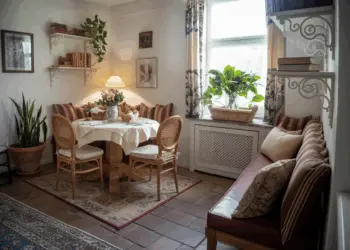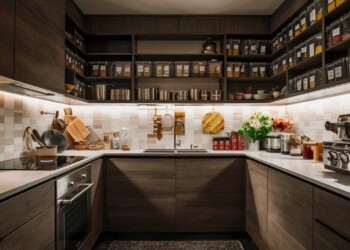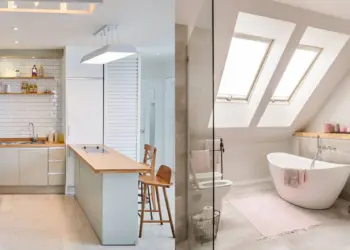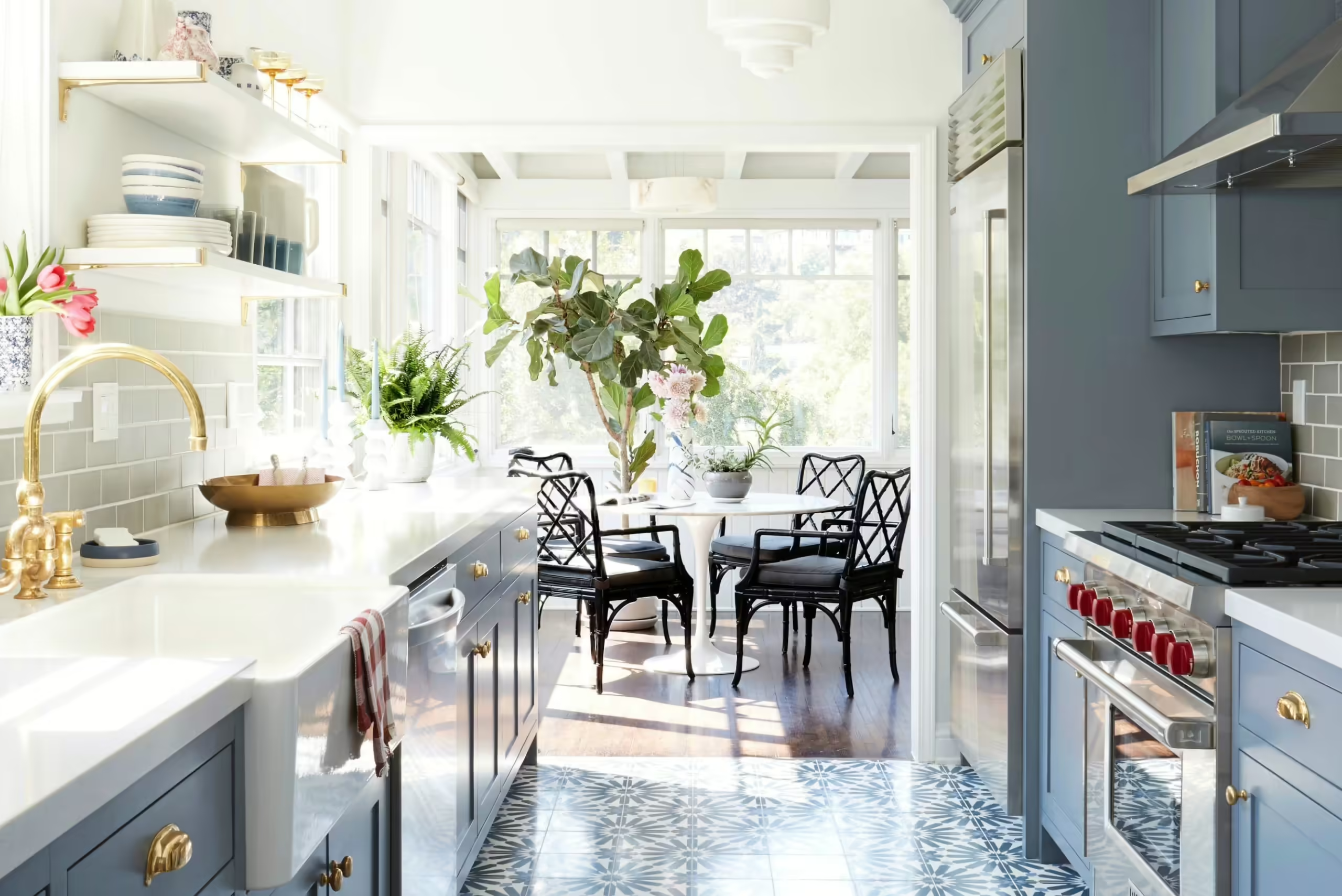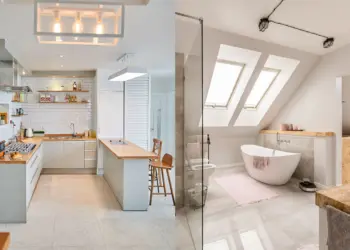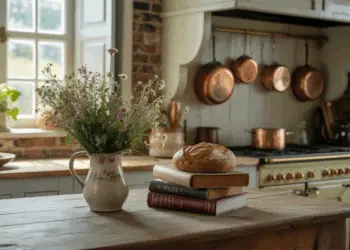When it comes to designing your dream kitchen, selecting the right color for your cabinets is a decision that can significantly impact the overall aesthetic. The harmony between cabinet color, backsplash, and flooring is crucial for achieving a cohesive and visually pleasing look. In this guide, we’ll explore the factors to consider for kitchen cabinet colors, the pros and cons of light vs. dark cabinets, and tips for making the right choices.
Table Of Content
Harmony in Kitchen Design: Creating a Cohesive Space
Achieving a harmonious kitchen design involves a thoughtful blend of elements, and one crucial aspect is the synchronization of cabinet color with the backsplash and flooring. Let’s delve into the significance of this harmony and how it contributes to the overall aesthetics of your kitchen.
1. Cohesive Aesthetics
Harmonizing the color palette between cabinets, backsplash, and flooring creates a cohesive visual experience. When these elements complement each other, the kitchen appears well-planned and aesthetically pleasing. The eyes move seamlessly across the space without encountering jarring contrasts.
2. Visual Flow and Continuity
A harmonious color scheme establishes a natural flow and continuity within the kitchen. This is particularly crucial in open-concept designs where the kitchen is part of a larger living space. Consistency in color promotes a sense of unity, making the entire area feel connected and well-integrated.
3. Enhanced Space Perception
The right color coordination can influence how we perceive space. Lighter colors tend to reflect more light, making the kitchen feel brighter and more expansive. Darker colors, when used strategically, can add warmth and coziness. By aligning cabinet color with backsplash and flooring, you can manipulate the perceived size and ambiance of the kitchen.
4. Focal Points and Accents
Creating a harmonious color scheme doesn’t mean everything has to be the same shade. It allows for the establishment of focal points and accents. For instance, if you have vibrant cabinets, a subtle and complementary backsplash can serve as an accent, drawing attention without overwhelming the space.
5. Personalized Style
Your kitchen is an extension of your personal style, and harmonizing colors provides a canvas for expressing that style. Whether you prefer a modern, sleek look with monochromatic tones or a more eclectic vibe with contrasting elements, the harmony in color ensures your design preferences shine through.
6. Balance and Avoiding Overwhelm
Without proper harmony, a kitchen can feel chaotic or overwhelming. Mismatched colors may create a disjointed appearance, making it challenging for the eyes to settle. Striking the right balance ensures that each element contributes to the overall beauty without competing for attention.
7. Resale Value
For those considering resale value, a harmonized kitchen design can be a strong selling point. Potential buyers are often drawn to kitchens that exude a sense of order and style. A well-coordinated color scheme suggests meticulous care and attention to detail, adding perceived value to the property.

Factors to Consider Before Choosing kitchen cabinet colors
Selecting the right color for your kitchen cabinets involves thoughtful consideration of various factors. consider the following key elements that should guide your decision, including the impact of natural light, the size of your kitchen, and the overall style you aim to achieve.
1. Natural Light
The Influence of Sunlight
Natural light has a profound effect on how colors appear in your kitchen. A well-lit kitchen can showcase a broader range of colors, from crisp whites to deep tones. Consider the direction and intensity of sunlight in your kitchen throughout the day. If your kitchen receives abundant natural light, you have the flexibility to explore both light and dark cabinet colors.
2. Kitchen Size
Creating Space Perception
The size of your kitchen is a crucial factor in determining cabinet colors. Lighter hues tend to open up space and create an illusion of a larger area. In smaller kitchens, opting for light-colored cabinets can enhance the feeling of spaciousness. Conversely, larger kitchens can accommodate a broader spectrum of colors, including darker tones that add warmth and coziness.
3. Overall Style
Aligning with Design Themes
Consider the overarching style you want to achieve in your kitchen. Different color schemes complement various design themes. For a modern, minimalist look, neutral tones and monochromatic schemes work well. Traditional kitchens often feature warm, classic colors. Assess your preferences and the existing or planned decor to ensure your cabinet color aligns harmoniously with the overall style.
4. Cabinet Material and Finish
Impact on Color Appearance
The material and finish of your cabinets can affect how colors are perceived. Wood grains, for example, add texture and can influence the way colors appear. Additionally, glossy finishes reflect more light, which can impact the overall brightness of the kitchen. Be mindful of these factors when choosing colors to achieve the desired visual effect.
5. Personal Preferences
Expressing Your Taste
Ultimately, your personal preferences play a significant role in the decision-making process. Consider colors that resonate with you and contribute to the ambiance you want to create in your kitchen. Whether you prefer a classic, timeless look or a bold, contemporary statement, your cabinet color should reflect your individual style and taste.

Matching with Backsplash
One of the key elements in achieving a harmonious kitchen design is ensuring that your cabinet color complements the backsplash. The backsplash serves as a focal point and can either enhance or clash with your cabinet color. For instance, if you have a vibrant or intricate backsplash, opting for neutral cabinet colors can provide balance and prevent visual overload.

Complementing the Floor
The kitchen floor is another significant canvas that influences the overall color scheme. Matching the cabinet color with the floor can create a seamless and unified appearance. If you have a dark floor, consider lighter cabinet shades to avoid a closed-in feeling. In contrast, light floors can accommodate both light and dark cabinet options, offering flexibility in your design choices.

Creating Contrast
While harmony is essential, introducing contrast strategically can elevate the visual interest of your kitchen. For instance, pairing light cabinets with a dark backsplash or vice versa can create a striking focal point. Just be cautious not to overdo it-balance is key.

Popular Color Combinations
Certain color combinations have stood the test of time in kitchen design. Classic pairings like white cabinets with a subway tile backsplash and a neutral floor are timeless choices. On the other hand, modern trends may lean toward bold contrasts, such as navy cabinets with a white herringbone backsplash.

Small Kitchen Considerations
In smaller kitchens, light colors can create a sense of openness and airiness. Consider soft tones like light grays, whites, or pastels to make the space feel larger. Mirroring the color of cabinets with the walls can further contribute to an expansive feel.

Large Kitchen Considerations
In more spacious kitchens, you have the luxury to experiment with a broader range of colors. Darker cabinets can add a touch of elegance and coziness, while lighter shades maintain a fresh and airy ambiance.

Cabinet Finishes and Textures
The finish and texture of your cabinets play a vital role in how colors are perceived. Matte finishes can create a contemporary look, while glossy finishes add a touch of sophistication. Textured cabinet surfaces, such as distressed or reclaimed wood, can introduce warmth and character.

Maintaining a Timeless Look
If longevity is a priority, consider neutral colors for cabinets. Whites, grays, and natural wood tones are less likely to go out of style, providing a timeless foundation for your kitchen.

Budget-Friendly Options
Achieving a stylish kitchen doesn’t always require splurging on high-end materials. Budget-friendly alternatives, like laminate or paint, can emulate the look of more expensive materials, offering cost-effective options for a chic kitchen makeover.
DIY Cabinet Painting Tips
For the adventurous DIYers, repainting cabinets can be a cost-effective way to transform your kitchen. Prep work is crucial-clean and sand surfaces thoroughly, use high-quality paint, and consider trendy color choices like sage green or navy blue for a modern touch.

In the end, the perfect color for your kitchen cabinets is a personal choice that considers both aesthetics and practicality. By understanding the interplay between cabinet color, backsplash, and flooring, you can create a kitchen that not only reflects your style but also stands the test of time.
FAQs
Can I mix different cabinet colors in my kitchen?
Certainly! Mixing cabinet colors can add visual interest, especially if done purposefully. Consider having a contrasting island or incorporating open shelving in a different hue.
How do I know if a color will look good in my kitchen?
Test samples in your actual kitchen lighting to see how they appear in different conditions. Natural light and artificial lighting can affect color perception.
Are dark cabinets suitable for small kitchens?
Yes, but it’s essential to balance dark cabinets with lighter elements to prevent the space from feeling cramped.
Should I follow current trends when choosing cabinet colors?
While trends can provide inspiration, prioritize colors that resonate with your personal style. Trends may come and go, but your preferences are enduring.
Can I paint over existing cabinets myself?
Absolutely. With proper preparation and quality materials, repainting cabinets can be a rewarding and budget-friendly DIY project.
Should kitchen cabinets be darker or lighter than walls?
It’s often recommended to create contrast, so if the walls are light, consider darker cabinets, and vice versa, for visual interest.
What is the most popular color for kitchen cabinets?
White remains a popular choice for kitchen cabinets due to its timeless and versatile appeal.
What color cabinets make a kitchen look bigger?
Lighter shades, like white or light gray, can create a sense of spaciousness in a kitchen.
Should all cabinets in a house be the same color?
While it’s common for kitchens to have a cohesive color scheme, other areas can have varied cabinet colors for added visual interest and personality.

